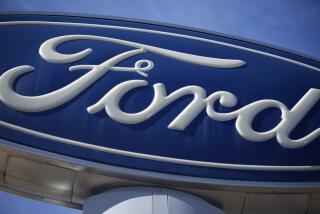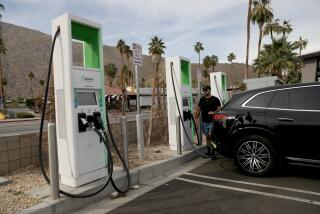GM Plans 2 New Low-Emission Models by 2004
DETROIT â Adding momentum to the clean-car movement, General Motors Corp. announced plans Sunday to produce a low-emission hybrid-electric vehicle by 2001 and a fuel-cell-powered car by at least 2004.
Both vehicles would still burn hydrocarbons--either gasoline, diesel fuel or methanol--but would get up to 80 miles per gallon and have a range comparable to todayâs gas-powered cars but with less than half the emissions.
GM, the worldâs largest auto maker, also said it would begin leasing its EV1 electric car this fall in California and Arizona with an advanced battery that will double its range to 160 miles. The battery will also be offered in GMâs electric S10 pickup.
âGM is committed to being a leader in the race to market commercially viable clean and green vehicles,â said John F. Smith Jr., GM chairman and chief executive officer.
However, company officials warned that commercialization hinged on making proper fuels available, reducing costs enough to make the cars affordable and gaining consumer acceptance.
The announcement at Detroitâs North American International Auto Show comes on the heels of last monthâs global warming conference in Japan, which resulted in an international treaty accord to reduce tailpipe emissions that are believed to cause global warming.
Other major auto makers have jumped on the green bandwagon, issuing a flood of commitments to develop and produce cleaner vehicles. For example, Ford is to announce today that it will put low-pollution technology in its 1999 model year sport utility vehicles and Windstar minivans. Despite these announcements, there is often more talk than action, environmentalists complain.
âThe auto makers are trying to outdo each other for the environmental mantle,â said Jason Mark, transportation analyst for the Union of Concerned Scientists, an environmental group. âThe challenge is to separate the wheat from the chaff.â
Among those given the most credibility are Toyota, which last month became the first auto maker to sell a hybrid-electric in Japan, and Daimler-Benz, which already has produced fuel-cell vehicle prototypes and vowed to mass produce them in six years. Ford last month became Daimlerâs partner with a $420-million investment.
GM is taken seriously if for no other reason than its size and vast technological resources. The company gained an environmental halo a year ago when it became the first auto maker to sell an electric vehicle built from the ground up since early in the century.
But sales of the innovative EV1 coupe have been disappointing, numbering a mere 300 in the first year. That performance and GMâs secrecy about its long-range plans prompted some speculation that the company had fallen behind in the race to market alternative-fuel vehicles.
On Sunday, GM dismissed such criticism as it unveiled plans for what top company officials touted as the broadest lineup of alternative fuel vehicles in the world. All the vehicles are based on the EV1 chassis and electric drive system. The hybrids and the fuel cell vehicle all use an EV1 chassis stretched 19 inches to provide seating for four occupants.
âWe donât think we are behind the curve,â said Smith, who symbolically wore a green sweater at the press conference. âWe think we are in the lead in technology.â
In all, GM unveiled plans for five new advanced fuel vehicles. The most advanced were the hybrid-electrics and a fuel-cell vehicle. Smith said the hybrids--which combine advanced combustion engines with an electric drive system--could be a mid-term environmental solution.
The use of the two systems in a hybrid increases efficiency since a combustion engine operates optimally at a constant speed, such as in highway cruising, and a battery-powered drive can efficiently provide supplemental boosts for passing or quick starts.
But in the long run, Smith said, the fuel cell is the favored candidate to replace the internal combustion engine.
The company said that two to three months ago it formed a global team to focus on fuel-cell development, tapping technology from its operations around the world. It declined to specify how much capital it is devoting to fuel-cell research, but Bryan McCormick, director of the program, said it was âsubstantial.â
Fuel cells combine hydrogen and oxygen without combustion to produce electricity. When pure hydrogen is used, the only emission is water. When another fuel is used to get hydrogen, there are some emissions but substantially less than from todayâs combustion engines.
McCormick said that GM is working on a fuel-cell system that incorporates a methanol processor. The company already has linked the system to a fuel-cell and electric drive system but has not yet put it into a vehicle.
GM is further along with the hybrids and said it would provide test drives of prototypes within a few months.
One hybrid GM is developing combines an electric motor with a micro gas-turbine generator. The vehicle can get 60 mpg, meet Californiaâs ultra-low emissions standards and travel 350 miles before refueling.
Another hybrid uses an electric motor and a direct injection turbo diesel engine. This system can get 80 mpg and go 550 miles on a tank of diesel. But it has higher particulate and nitrous oxide emissions. GM said it is working with Amoco to reduce those pollutants.
Officials said it was too early to make volume or price estimates for the hybrid and fuel-cell vehicles, and there are many problems to be overcome before sales to the public would begin.
âThere are still technological challenges and cost challenges,â said Harry Pearce, GM vice chairman. âIt does no good to put them on the street if no one buys them.â
GM also displayed a compressed natural gas vehicle based on the EV1 frame at the Detroit auto show. The CNG tanks replace the battery pack, saving 770 pounds. Emissions are just one-tenth of Californiaâs standards, GM said.
The auto maker said that it would begin this fall replacing the lead-acid battery packs now in its EV1 with nickel-metal-hydride batteries. The new batteries, which are more expensive, will increase range from 70-90 miles to 160.
The lease price of the EV1 with the nickel battery packs has not been set, but Jack Nowicki, director of finance for electric vehicles, said GM would be competitive with rivals. The EV1 now leases for about $399 a month with lead acid batteries; Hondaâs EV Plus with nickel batteries goes for $499.






